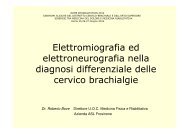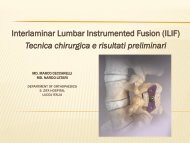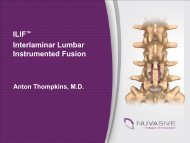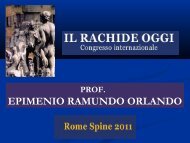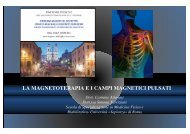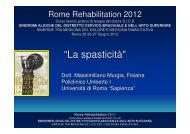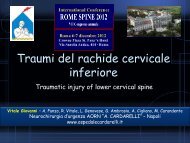Lumbar Facet Joint Replacement
Lumbar Facet Joint Replacement
Lumbar Facet Joint Replacement
You also want an ePaper? Increase the reach of your titles
YUMPU automatically turns print PDFs into web optimized ePapers that Google loves.
Rome Spine 2011<br />
THE SPINE TODAY<br />
International Congress<br />
Rome 6-7th December 2011<br />
<strong>Lumbar</strong><br />
<strong>Facet</strong> <strong>Joint</strong> <strong>Replacement</strong><br />
Prof. Dr. Karin Büttner-Janz<br />
Past President<br />
International Society for the Advancement<br />
of Spine Surgery<br />
Director of Orthopaedic Clinic<br />
Vivantes Hospital im Friedrichshain<br />
+49 30 130 23 1306<br />
Director of Traumatologic and Orthopaedic Clinic<br />
Vivantes Hospital Am Urban<br />
+49 30 130 22 6201<br />
Vivantes Hospital Company, Berlin – Germany<br />
karin.buettner-janz@vivantes.de<br />
karin.buettner-janz@vivantes.de
Motion Retaining Devices for:<br />
Repair, Preservation or Improvement of<br />
Function - including Motion<br />
of the Cervical and <strong>Lumbar</strong> Functional Spinal Unit<br />
• <strong>Lumbar</strong> Total Disc <strong>Replacement</strong><br />
• Cervical Total Disc <strong>Replacement</strong><br />
• Nucleus <strong>Replacement</strong><br />
• Posterior Dynamic Stabilisation / Screws + Connectors<br />
• Posterior Dynamic Stabilisation / <strong>Facet</strong> <strong>Joint</strong> <strong>Replacement</strong><br />
• Posterior Dynamic Stabilisation / Interspinous Implants<br />
• Implant Combination
1. Basics of <strong>Lumbar</strong> <strong>Facet</strong> <strong>Joint</strong>s<br />
2. Classification of <strong>Facet</strong> <strong>Joint</strong> <strong>Replacement</strong><br />
3. Clinical Results<br />
AGENDA<br />
4. <strong>Facet</strong> <strong>Joint</strong> <strong>Replacement</strong> (FJR) after<br />
Total Disc <strong>Replacement</strong> (TDR)
Anatomy and Biomechanics<br />
“Three-<strong>Joint</strong>-Complex”<br />
Spinal Motion Segment<br />
[= Functional Spinal Unit]<br />
– 1 Disc<br />
– 2 <strong>Facet</strong> <strong>Joint</strong>s
Location based <strong>Facet</strong> <strong>Joint</strong> Function<br />
Cervical Spine:<br />
• Lowest transmitted loads of the spine<br />
• Most freedom in lateral bending, extension<br />
and axial rotation<br />
<strong>Lumbar</strong> Spine:<br />
• <strong>Facet</strong>s are larger, more centrally located, and<br />
almost parallel along the sagittal plane<br />
• Lateral bending is limited<br />
• Stop for hyper-extension and axial rotation<br />
Variation in facet orientation and location within vertebral regions<br />
(White and Panjabi, Clinical Biomechanics of the Spine, 2 nd Ed.)
<strong>Facet</strong> Morphology<br />
<strong>Facet</strong> Angle<br />
<strong>Facet</strong> Curvature
<strong>Facet</strong> <strong>Joint</strong> Degeneration<br />
Grade I Grade II<br />
Grade III Grade IV<br />
[Fujiwara, et al., Spine (2000) 25:23, pp 3036–3044]<br />
Grade I Grade II<br />
Grade III Grade IV<br />
[Tischer, T. et al., Eur. Spine J. (2006) 15: 308–315]<br />
• Grade I: uniformly thick cartilage covers the articular surfaces completely.<br />
• Grade II: cartilage covers the entire surface of the articular process but an<br />
eroded irregular region is evident.<br />
• Grade III: cartilage incompletely covers the articular surfaces with regions<br />
of underlying bone exposed to the joint.<br />
• Grade IV: cartilage is absent except for traces on the articular process.
1. Basics of <strong>Lumbar</strong> <strong>Facet</strong> <strong>Joint</strong>s<br />
2. Classification of <strong>Facet</strong> <strong>Joint</strong> <strong>Replacement</strong><br />
3. Clinical Results<br />
3. FJR after TDR<br />
AGENDA
Classification of <strong>Facet</strong> <strong>Joint</strong> <strong>Replacement</strong> according to<br />
• Design<br />
• Material<br />
(further developed to Büttner-Janz, 2008; In: Motion Preservation Surgery of the Spine)<br />
1. <strong>Facet</strong> Resurfacing / Partial <strong>Facet</strong> <strong>Joint</strong> <strong>Replacement</strong><br />
a) Plastic<br />
b) Metal<br />
c) Combination of metal and plastic<br />
2. Total <strong>Facet</strong> <strong>Joint</strong> <strong>Replacement</strong><br />
a) Plastic<br />
b) Metal<br />
c) Combination of metal and plastic<br />
3. Three <strong>Joint</strong> <strong>Replacement</strong><br />
(<strong>Facet</strong> <strong>Joint</strong> <strong>Replacement</strong> + Disc <strong>Replacement</strong> at same<br />
segment + time)<br />
a) Combination with Nucleus <strong>Replacement</strong><br />
b) Combination with Total Disc <strong>Replacement</strong><br />
(implantation via ventral, lateral or dorsal approach)
Examples<br />
Classification of <strong>Facet</strong> <strong>Joint</strong> <strong>Replacement</strong> according to<br />
• Design<br />
• Material<br />
(further developed to Büttner-Janz, 2008 - In: Motion Preservation Surgery of the Spine)<br />
1. <strong>Facet</strong> Resurfacing / Partial <strong>Facet</strong> <strong>Joint</strong> <strong>Replacement</strong><br />
Does not violate the pedicles = Minimal invasive surge<br />
a) Plastic<br />
b) Metal<br />
c) Combination of metal and plastic<br />
ZYRE <strong>Facet</strong> Implant System FENIX Resurfacing System Zyga GLYDER Device
Examples<br />
Classification of <strong>Facet</strong> <strong>Joint</strong> <strong>Replacement</strong> according to:<br />
• Design<br />
• Material<br />
(further developed to Büttner-Janz, 2008; In: Motion Preservation Surgery of the Spine)<br />
2. Total <strong>Facet</strong> <strong>Joint</strong> <strong>Replacement</strong><br />
Violates the pedicles, vertebrae, laminae, muscles and ligaments<br />
= Maximale invasive surgery<br />
a) Plastic<br />
b) Metal<br />
c) Combination of metal and plastic<br />
TFAS TFAS-LS ACADIA<br />
<strong>Facet</strong> <strong>Replacement</strong> System<br />
TOPS System<br />
TOP SP System is<br />
30% smaller device.<br />
Not yet implanted in human.
Examples<br />
Classification of <strong>Facet</strong> <strong>Joint</strong> <strong>Replacement</strong> according to:<br />
• Design<br />
• Material<br />
(further developed to Büttner-Janz, 2008; In: Motion Preservation Surgery of the Spine)<br />
2. Total <strong>Facet</strong> <strong>Joint</strong> <strong>Replacement</strong><br />
Violates the pedicles, vertebrae, laminae, muscles and ligaments!<br />
= Maximale invasive surgery<br />
a) Plastic<br />
b) Metal<br />
c) Combination of metal and plastic<br />
IN VITRO:<br />
Auxiliary <strong>Facet</strong> System (AFC)<br />
Yann Philippe Charles et al.:<br />
SPINE 2011 Volume 36, Number 9, pp 690–699<br />
(2 angulated rods, polyaxial connectors, crosslink,<br />
4 pedicel screws – all metal components)
Examples<br />
Classification of <strong>Facet</strong> <strong>Joint</strong> <strong>Replacement</strong> according to:<br />
• Design and<br />
• Material<br />
(further developed to Büttner-Janz, 2008; In: Motion Preservation Surgery of the Spine)<br />
3. Three <strong>Joint</strong> <strong>Replacement</strong><br />
(<strong>Facet</strong> <strong>Joint</strong> <strong>Replacement</strong> + Disc <strong>Replacement</strong> at same segment + time)<br />
Violates the disc, pedicles, vertebrae, laminae, muscles, ligaments!<br />
= „Most maximale“ invasive surgery<br />
a) Combination with Nucleus <strong>Replacement</strong><br />
b) Combination with partial oder Total Disc <strong>Replacement</strong><br />
(disc implantation via ventral, lateral or dorsal approach)<br />
Inlign Total Motion Segment
1. Basics of <strong>Lumbar</strong> <strong>Facet</strong> <strong>Joint</strong>s<br />
2. Classification of <strong>Facet</strong> <strong>Joint</strong> <strong>Replacement</strong><br />
3. Clinical Results<br />
3. FJR after TDR<br />
AGENDA
<strong>Facet</strong> Recurfacing:<br />
• Painful Degeneration of <strong>Facet</strong> <strong>Joint</strong> (after Denervation)<br />
• Post TDR <strong>Facet</strong> <strong>Joint</strong> Disease<br />
• Inflammation of <strong>Facet</strong> <strong>Joint</strong><br />
• Cyst of <strong>Facet</strong> <strong>Joint</strong><br />
Indications<br />
• “<strong>Facet</strong> Kicking Syndrome” (after Fusion, TDR - L.Pimenta)<br />
• (Degenerative Spondylolisthesis)
Zyre <strong>Facet</strong> Implant System (2007)<br />
With / without bone resection.<br />
Lauryssen et al. 2008: Minimal-invasiv surgery as stand alone<br />
device or in combination with other motion retaining devises.<br />
No clinical data available<br />
FENIX Resurfacing System (2007)<br />
van de Kelft 2009: 8 patients, mean age 53 y<br />
After 1 year 6 patients satisfied, still motion at operated level.<br />
ODI 48 preop. 18 postop., VAS 7.2 preop. 2.5 postop.<br />
1 case with spinal canal revision surgery at upper adjacent level<br />
1-2011: 15 patients operated, 2-years follow up, CE-approval
Zyga GLYDER Device (2010)<br />
Surgical Goals:<br />
• Reduced pain or pain-free facet joint<br />
• Maintains natural facet joint motion<br />
• Maintains native anatomy<br />
• Maintains option for Total <strong>Facet</strong> <strong>Joint</strong><br />
<strong>Replacement</strong><br />
• Maintains option for fusion surgery<br />
Pt/Ir marker Pt/Ir marker<br />
• PEEK polymer with Platinum / Iridium Marker<br />
• Teeth on backside to prevent dislocation<br />
• Small size: 9 x 11 mm (L12 and L23)<br />
• Large size: 12 x 14 mm (L3-S1)<br />
Not yet CE approved<br />
L. Pimenta/Brasilia
Zyga GLYDER Device<br />
Results of Luiz Pimenta:<br />
• 18 patients (mean age 44 years)<br />
– post TDR facet joint disease<br />
– facet joint degeneration/disease<br />
– kicking facet syndrome (after fusion)<br />
• Indication: Pain- at preop facet injection<br />
• Incl. double level cases<br />
• Surgical duration ≈ 98 min<br />
• Follow-up ≈ 6 months
Zyga GLYDER Device<br />
Hans Jörg Meisel/Germany:<br />
• 3 patients<br />
Surgery Dec 1st 2011
Zyga GLYDER Device
Indications<br />
Total <strong>Facet</strong> <strong>Joint</strong> <strong>Replacement</strong>:<br />
• Symptomatic Spinal Canal Stenosis with<br />
indication for facet joint removal
TOPS (2004)<br />
5-year follow up‘s available with successful results.<br />
After adaptation to smaller implant further surgeries are planned.<br />
Company was re-bought.
TFAS (2005)<br />
Not any more on market.<br />
Company was bought by another company.<br />
ACADIA (2005)<br />
Since 2009 US Pivotal Study.<br />
Castellvi (2009): 106 patients, mean age 60 years (34-82):<br />
After 12 postop months ODI improved 79%,<br />
back pain 53%, leg pain 67%.<br />
No re-operation, no implant problem.<br />
Company was bought by another company.
TFAS – Case Report<br />
Case 1<br />
Case 2<br />
Stem fracture after total facet replacement<br />
in the lumbar spine: a report<br />
of two cases and review of the literature<br />
Daniel K. Palmer, BS, Serkan Inceoglu,<br />
PhD, Wayne K. Cheng, MD<br />
The Spine Journal 11 (2011) e15–e19<br />
Case 1: A 55-year-old man with a body mass index (BMI) of 40 underwent<br />
total facet replacement at L4–L5 for Grade 1 spondylolisthesis with stenosis.<br />
After 9 months of pain relief, he experienced gradually increasing pain and<br />
radiographs showed a broken stem.<br />
Case 2: A 60-year-old woman with a BMI of 31 underwent total facet<br />
replacement at L4–L5 for Grade 1 spondylolisthesis with stenosis. She<br />
experienced stem fracture 27 months postoperatively.<br />
Treatment: Trans-psoas interbody fusion<br />
surgery
Indications<br />
“Three <strong>Joint</strong> <strong>Replacement</strong>”:<br />
• Includes indications of TDR + FJR
Inlign Total Motion Segment (2008)<br />
Study with 50 patients was started.<br />
Results are unknown.
1. Basics of <strong>Lumbar</strong> <strong>Facet</strong> <strong>Joint</strong>s<br />
2. Classification of <strong>Facet</strong> <strong>Joint</strong> <strong>Replacement</strong><br />
3. Clinical Results<br />
3. FJR after TDR<br />
AGENDA
TDR: ►<strong>Facet</strong> <strong>Facet</strong> <strong>Joint</strong> <strong>Joint</strong> Degeneration<br />
Kube et al. SAS 2006:<br />
Outcome in lumbar disc arthroplasty is related to grade of facet arthropathy.<br />
Chan Shik Shim et al. SPINE 2007:<br />
• 57 patients >3 years follow up (MRI: 52 patients)<br />
• Charité 33, Prodisc 24<br />
• Both groups with facet joint degeneration<br />
Park et al. SPINE 2008:<br />
• Prodisc 46 patients min. 2 years follow up<br />
• MRI and CT preop and 2 years F/U: 29.3% progressive facet degeneration<br />
Siepe et al. SPINE 2010:<br />
• Prodisc 93 patients min. 2 years follow up (Ø 53,4 months)<br />
• X-ray and MRI preop and postop F/U: 20.0% facet joint degeneration (FJD)<br />
• FJD more often at level L5/S1; FJD associated with negative clinical outcome<br />
and lower ROM
► TDR TDR + + <strong>Replacement</strong> of of <strong>Facet</strong> <strong>Facet</strong> <strong>Joint</strong>s <strong>Joint</strong>s<br />
2 years after Charité Artificial Disc:<br />
TFAS LS cementless<br />
(Implantation 09-2008)<br />
Excising of complete pain generator<br />
Alternatively:<br />
Zyga GLYDER Device
Compact total disc: Less facet joint degeneration / disease?<br />
No adjacent level disease?<br />
SL, f: Nucleotomy: 33 years; Charité disc: 34 years; Freedom disc: 38 years<br />
CHARITÉ + FREEDOM<br />
Extension Flexion
<strong>Facet</strong> <strong>Facet</strong> <strong>Joint</strong> <strong>Joint</strong> <strong>Replacement</strong> – – Conclusion and and Questions<br />
1. From clinical point of view the „pain generator“ facet joint is as important as<br />
the intervertebral disc. From anatomical and biomechanical point of view the<br />
lumbar facet joints are to replace. Therefore, carefully diagnostics is needed<br />
before surgery.<br />
2. Surgery: Only a few devices are on market. While the main indication for<br />
total facet joint replacement is a symptomatic spinal canal stenosis, the single<br />
facet joint disease could be the main indication for facet recurfacing. At time of<br />
device implantation thinking on potential revision surgery.<br />
3. Spherical ball and socket type of total discs includes the danger for facet<br />
joint degeneration and disease. Question: Is there an indication for facet<br />
recurfacing preoperatively or postoperatively?<br />
4. Future: At least mid term clinical studies are needed of facet recurfacing and<br />
total facet joint replacement.
Berlin





